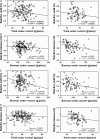Genetic basis of drought resistance at reproductive stage in rice: separation of drought tolerance from drought avoidance
- PMID: 16272419
- PMCID: PMC1456219
- DOI: 10.1534/genetics.105.045062
Genetic basis of drought resistance at reproductive stage in rice: separation of drought tolerance from drought avoidance
Abstract
Drought tolerance (DT) and drought avoidance (DA) are two major mechanisms in drought resistance of higher plants. In this study, the genetic bases of DT and DA at reproductive stage in rice were analyzed using a recombinant inbred line population from a cross between an indica lowland and a tropical japonica upland cultivar. The plants were grown individually in PVC pipes and two cycles of drought stress were applied to individual plants with unstressed plants as the control. A total of 21 traits measuring fitness, yield, and the root system were investigated. Little correlation of relative yield traits with potential yield, plant size, and root traits was detected, suggesting that DT and DA were well separated in the experiment. A genetic linkage map consisting of 245 SSR markers was constructed for mapping QTL for these traits. A total of 27 QTL were resolved for 7 traits of relative performance of fitness and yield, 36 QTL for 5 root traits under control, and 38 for 7 root traits under drought stress conditions, suggesting the complexity of the genetic bases of both DT and DA. Only a small portion of QTL for fitness- and yield-related traits overlapped with QTL for root traits, indicating that DT and DA had distinct genetic bases.
Figures


References
-
- Ali, M. L., M. S. Pathan, J. Zhang, G. Bai, S. Sarkarung et al., 2000. Mapping QTLs for root traits in a recombinant inbred population from two indica ecotypes in rice. Theor. Appl. Genet. 101: 756–766.
-
- Babu, R. C., B. D. Nguyen, V. Chamarerk, P. Shanmugasundaram, P. Chezhian et al., 2003. Genetic analysis of drought resistance in rice by molecular markers: association between secondary traits and field performance. Crop Sci. 43: 1457–1469.
-
- Blum, A., 1988. Drought Resistance: Plant Breeding for Stress Environments. CRC Press, Boca Raton, FL.
-
- Bolanos, J., and G. O. Edmeades, 1996. The importance of the anthesis-silking interval in breeding for drought tolerance in tropical maize. Field Crops Res. 48: 65–80.
-
- Boonjung, H., and S. Fukai, 2000. Effects of soil water deficit at different growth stages on rice growth and yield under upland conditions. 2. Phenology, biomass production and yield. Field Crops Res. 43: 47–55.
Publication types
MeSH terms
Substances
LinkOut - more resources
Full Text Sources
Medical

